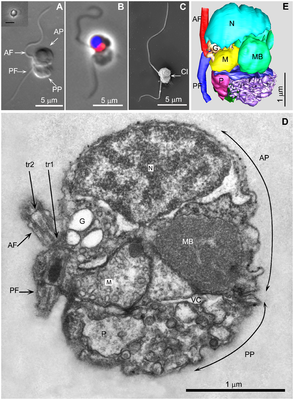Picozoa
| Picozoa | ||||||||
|---|---|---|---|---|---|---|---|---|

|
||||||||
| Systematics | ||||||||
|
||||||||
| Scientific name | ||||||||
| Picozoa | ||||||||
| Seenivasan , Sausen , Medlin & Melkonian , 2013 | ||||||||
The Picozoa are a strain of heterotrophic protozoa from the domain of the eukaryotes that was newly described in 2013 . They are the smallest forms of living creatures floating freely in the water, are between half a and 3.8 µm ( micrometers ) in size and are found in large numbers and densities in all oceans.
History of discovery and evidence
At the end of the 1990s, the European project “Picodiv” was supposed to clarify which organisms occur in picoplankton . For two years, samples were taken in the Atlantic, in the Mediterranean, off Scotland, Alaska and Norway. Picozoa were found mainly in the nutrient-poor areas of cold coastal seas, where they can make up up to 50 percent of the biomass .
Picozoa are so small that they can hardly be seen as living things under a light microscope . The detection was achieved via the 18S-r gene, from which the 18S-rRNA is read. It is a component of the ribosomes and the 18S version is clear evidence of a eukaryotic origin. Since the 18S rRNA mutates slightly over long periods of time, it can be used to construct evolutionary pedigrees .
The unknown 18S rRNA sequences found in the sea samples showed that the Picozoa must be classified in a previously unknown class. It has been suggested that these are algae-like organisms, but that they are not closely related to any known class of eukaryotes. Oligonucleotides could be constructed for the sequences and the organisms made visible using the FISH technique. The Picozoa contain a small, round organelle with phycobiliproteins , which is why it was originally assumed that they could be photosynthetically active.
In 2013, Picomonas judraskeda , the first and so far only described species from the group, was described . The species was part of a doctoral thesis by means of a fluorescent mitochondria - the marker of a sea water sample before the harbor of Helgoland was taken at a depth of 5 meters, isolated and then cultured in the laboratory. Since no signs of the presence of plastids , cell organelles of plants or algae , could be found in the investigations , it is assumed that the unicellular organisms feed on heterotrophically . At the same time as the species, the genus, family, order and class were described and the organisms previously known as Picobiliphyta and Biliphyta were described as the new strain Picozoa.
features
The Picozoa be as heterotrophic , marine, pikoplanktonische (the cells pass through a 3 micron membrane filter) protists diagnosed , mostly by one of the two characteristic sequences encoded the core SSU rDNA 5'GCG TGA TGC CAA AAT CCG3 '(PICOBI01) or 5′ATA TGC CCG TCA AAC CGT3 ′ (PICOBI02) are marked.
The other characteristics found in Picomonas judraskeda , including the cell divided into two hemispheres, the two flagella and the jerky movement cycle are not used to diagnose the new strain, as it is not certain whether they can also be found in other species. However, the scientists suspect that this will be the case for most traits.
Systematics
A phylogenetic analysis, in which a total of 104 eukaryote taxa from almost all supergroups were examined (only the Excavata were missing ), could not assign the Picozoa to one of the known systematic supergroups of the eukaryota. A great genetic diversity can be detected within the Picozoa and 12 clades can be distinguished for the time being.
literature
- Fabrice Not, Klaus Valentin, Khadidja Romari, Connie Lovejoy, Ramon Massana, Kerstin Töbe, Daniel Vaulot, Linda K. Medlin: Picobiliphytes. A Marine Picoplanktonic Algal Group with Unknown Affinities to Other Eukaryotes . In: Science , Vol. 315 (2007), No. 5809, pp. 253-255, ISSN 0036-8075 , doi : 10.1126 / science.1136264
- Georg Kääb: A new world so small. New class of eukaryotes discovered, Picobiliphyta . In: biologists today . No. 1, 2007, pp. 18f., ISSN 1432-8631 .
- Ramkumar Seenivasan, Nicole Sausen, Linda K. Medlin, Michael Melkonian: Picomonas judraskeda Gen. Et Sp. Nov .: The First Identified Member of the Picozoa Phylum Nov., a Widespread Group of Picoeukaryotes, Formerly Known as 'Picobiliphytes'. PLoS ONE 8 (3): e59565. doi: 10.1371 / journal.pone.0059565
Individual evidence
- ↑ Fabrice Not et al. (2007)
- ^ ML Cuvelier, A. Ortiz, E. Kim, H. Moehlig, DE Richardson (2008): Widespread distribution of a unique marine protistan lineage. Environ Microbiol. 2008 June; 10 (6): 1621-1634. doi: 10.1111 / j.1462-2920.2008.01580.x
- ↑ a b Seenivasan et al. (2013), p. 12.
- ↑ Seenivasan et al. (2013), p. 14.